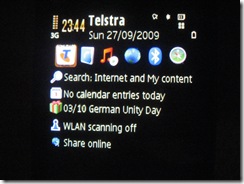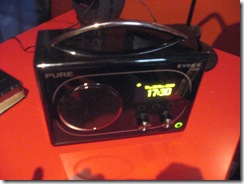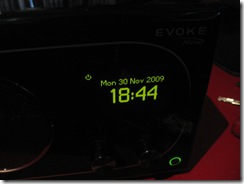Introduction
 I am reviewing the Nokia N85 3G Multimedia Phone, which is part of Nokia’s high-end “N-series” multimedia phones. It has been positioned as a second-tier model in their lineup and is one that can be easily missed in the crowded multipurpose mobile phone market, especially where this market is dominated by the Apple iPhone for personal use and the Blackberry phones for business use.
I am reviewing the Nokia N85 3G Multimedia Phone, which is part of Nokia’s high-end “N-series” multimedia phones. It has been positioned as a second-tier model in their lineup and is one that can be easily missed in the crowded multipurpose mobile phone market, especially where this market is dominated by the Apple iPhone for personal use and the Blackberry phones for business use.
Software availability
This phone is part of the Symbian S60 Version 3 platform which has a wide availability of software from different places. This means that additional functions can be added “off the Web” by visiting Handango, software providers’ Web sites and S60-themed Web sites as well as the Ovi application store. This puts it as a decent alternative to the Apple iTunes App Store model that is being implemented by the “King Of Cool” with the iPhone.
As a multimedia phone terminal

The N85's high-contrast OLED display
The display is based on OLED technology rather than the usual LCD technology which makes it easier to read in all light. The display is very bright and can be seen at extreme angles. Infact, I consider this display the “vacuum-fluorescent display for battery-operated devices” because it has the same brightness and consistency as the vacuum-fluorescent displays used on most home-installed consumer-electronics devices, especially Panasonic or Sony equipment. A disadvantage that this display may have is that this may lead to some pictures, especially some photographs, appearing too saturated and with a bit too much contrast but it may be how the OLED display reproduces the pictures. It may be a boon with text or diagrams such as the Ovi Maps.
The phone’s battery life is very good even when used as a music player as well as a phone. If you use 3G or WiFi data connectivity or the integrated navigation functionality for a significant amount of time, you can compromise the battery life. You can get around this problem while getting the most out of the phone while you are out and about but cannot readily use the supplied charger by investing in an external battery pack such as one of those “AA-battery”-powered mobile phone chargers. The phone’s MicroUSB socket is its power socket, which means that USB=based power devices used along with a micro-USB flylead can become the phone’s external power supply. The only problem with this is that some USB hubs may not be logically seen by the phone as a charger.
The phone as a GPS unit
The phone has integrated GPS but I am using this function with Ovi-based Maps 3.0 with City Guide subscription. For people who do a lot of walking, the subscription is very good value. One thing that I would like to see in the maps data is public paths for use by low-speed traffic like pedestrians, cyclists or horseback riders; but this is an issue with Navteq and the data they provide to Nokia. The GPS function can be used by other S60 3rd Edition location-driven applications like Nokia’s Sport Tracker GPS pedometer / workout diary or Google’s S60 siftware.
The phone as a Walkman
This phone beats the iPhone when it comes to personal-stereo functionality. This is demonstrable in the FM radio and the integrated music player, especially in how you can add music to the phone.
The phone has an integrated RDS FM radio which works only with wired headsets because the headset’s wire also is the radio’s aerial. There are a few discrepancies when it comes to working with RDS-enabled FM stations. If you preset an RDS radio station, the callsign details that are supplied through RDS aren’t used as a default station reference name. Instead, you have to manually copy the station’s name in to the station’s preset details. The phone doesn’t work with the so-called “dynamic RDS” features like TA/TP/EON traffic-information priority – a feature which can be a boon to public-transport users; PTY program-type functionality (including news priority) or RadioText dynamic text display. It does work with Visual Radio, which is an interactive radio service with 3G or WiFi as data backhaul.
The built-in music player is definitely flexible when it comes to handling music content because it works from music held on the microSDHC cards up to 16Gb / card in capacity. These can be exchanged at will in a similar manner to the classic cassette or MiniDisc formats. Similarly, you can enlarge the storage capacity by upgrading the memory card to a higher capacity. It is compatible with the SlotMusic “musicassette” idea that Sandisk put forward; and the MicroSDHC cards can be loaded with music through a “drag-drop” method via the file system and Nokia PC Suite or directly on to the microSDHC card in an SDHC card reader with the use of an SD card adaptor; or the phone can be synced through Nokia PC Suite or Windows Media Player.
As well, you can download content from a DLNA music server that you are connected to via the WiFi network. This yields a lot more flexibility than the Apple iPod / iPhone system when it comes to adding newer music to your portable collection As far as codecs are concerned, the phone works with MP3, WMA and AAC codecs and can work with WMA up to 192kbps and MP3 up to 320kbps. The music player is operated in a manner similar to most MP3 players and if you make or take a call, the music pauses and resumes from where it left off. There is even the nice touch of the music fading up gracefully when you finish the call.
The integrated camera
The integrated camera is capable of high-resolution pictures and works well as an auxiliary camera if your main digital camera is out of action. It also works very well for video photography and will use the available memory on the microSD card for the footage rather a particular time limit.
One main problem with it is that if you intend to take pictures to send as MMS messages, it will prefer to send the high-resolution pictures which may not work with most mobile phones. To send an MMS, you would have to set the camera to work at a lower resolution before you take the picture. The picture you save would be a low-resolution picture. A point of improvement that could exist would be to have downscaling for MMS images when an image is sent as an MMS message.This is where a downscaled copy of the image is sent out as an MMS image.
Other than that, pictures and video that you take with the built-in camera can be transferred or printed out using PTP, Picthridge or Bluetooth or a PC can import pictures using Nokia PC Suite and any of the picture import functions that are part of Windows.
There is also a low-resolution camera on the front of the phone which comes in handy if you make a 3G videocall, but you can select to use the main camera during the videocall if you intend to show the other caller something rather than yourself.
Connectivity
As far as regular mobile-phone connectivity goes, this phone offers whatever is expected from a high-end mobile phone or smartphone.
The phone has a MicroUSB data and power socket and a 3.5” 4-conductor jack for headphones / AV lineout and headset / audio adaptor use. I use the phone with a Nokia-supplied headset audio adaptor with built-in microphone that is connected to a set of premium headphones so as to gain good-quality sound. The phone can connect to cassette adaptors for use with car cassette players or classic ghetto blasters; either directly or through an audio adaptor.
The main problem I have had with the audio adaptors is their flimsy tie-clips anchored to these adaptors that break under typical use. If this happens to you, I would suggest using either a metal “bobby-pin” or tie-clip; or a regular plastic clothes-peg from the laundry, attached to the audio adaptor with a rubber band. The only problem is that it may look a bit ugly especially in conjunction with formal wear or good headphones; and, for women, may be uncomfortable against the cleavage. To do this, wrap the rubber band around the audio adaptor making sure it isn’t pressing any of the buttons. Then open the clothes-peg, tie-clip or “bobby-pin” and pass one of the jaws of the clip through the rubber band. You then are able to clip the audio adaptor to your collar, lapel or tie with the tie clip, clothes peg or “bobby pin”.
The phone has a built-in PLL-controlled FM transmitter which you can use alongside an FM radio for music playback. If it was able to use this FM-based link for handsfree calling, I wouldn’t use that functionality at all because of having to set up the radio to handle the call every time a call comes in – one step too many.
The Bluetooth functionality is equally comprehensive in that is supports the Headset and Handsfree profiles for handsfree calling; A2DP / AVRCP audio playback profiles for music streaming functionality; and SIM Card Profile and Phone Book Profile for the increasing number of advanced in-car handsfree devices available with newer premium vehicles or on the aftermarket. This certainly means that the phone can partner with all of the good Bluetooth headsets and helmets as well as all of the good in-car handsfree setups.
Existence in the small network
WiFi Networks
The phone’s main method of connection to a small home or business network is through the built-in WiFi transceiver.
This transceiver works with 802.11g WPA networks that work purely to the WPA or WPA2 modes as well as to insecure WEP networks. This avoids routers or access points that are set up for WEP/WPA compatibility modes. For business and other high-security networks, the phone can work with most EAP-based enterprise security network setups; including SIM-based security. The phone can be programmed to work with wireless networks that have their SSID hidden, with use of a “hidden” option when you create an access point. The WiFi radio is very sensitive, which can come in handy whenever you use wireless hotspots.
The main gap the the phone has concerning WiFi-network connectivity is the lack of ability to support the WPS easy-enrolment setup that is becoming the norm for currently-issued wireless routers.
UPnP / DLNA Functionality
The phone works “out of the box” as a media player to the phone’s display and speakers or as a UPnP AV Control Point for pushing content held locally or on anther DLNA media server to another UPnP AV / DLNA Media Renderer device. It can also share content held on its memory card to a DLNA Media Network. Playlist management – can it push the contents of a container to a device?
Mail terminal
The built-in Symbian mail client supports IMAP4 and POP3/SMTP e-mail systems and uses a similar auto-setup routine to Windows Live Mail, where you just supply your fully-qualified e-mail address and password and the phone just works it out. The client is a similar standard to what is integrated in most smartphones but due to 12-key data entry, may be best used for reading e-mail and sending short replies or notes.
Web browsing
The web-browsing experience is similar to most other smartphones and is limited by the small screen. It can be viewed horizontally by selecting a mode to “view horizontal”. Password entry for social-networking and similar pages can be difficult due to the 12-key text-entry method primarily used in this class of phone.
Internet Radio
There is an integrated Internet Radio receiver function that can work with WiFi networks or 3G networks. If you want to use this function with a 3G network, it will need to work on an “all-you-can-eat” data plan if you want to do a lot of Internet-radio listening. The station directory is similar to that offered by Reciva or vTuner; which means having the stations sorted by country or genre. The phone can also “pipe” the Internet radio sound through the Bluetooth A2DP audio stream which allows you to play Internet radio broadcasts through Bluetooth speakers and similar audio accessories.
Conclusion, including the phone’s “cool factor”
This phone will appeal to the mature users who want a fully-functional yet flexible multimedia mobile phone but don’t intend to do a lot of text entry on it. As well, the phone “sets the cat amongst the pigeons” with the OLED display which is different from the LCD-display norm, thus can appeal to those who don’t have good eyesight.
What Nokia needs to do is to offer phones equipped with this OLED display and Symbian S60 to cut in to established smartphone markets like the QWERTY-keypad business phone (whether Blackberry-style or lengthways) or the touchscreen phone.
I have bought this phone on a published 24-month Telstra 3G “cap” contract under the regular terms and conditions for all customers who sign up to the contract. Therefore I am not writing this out of fear or favour.




